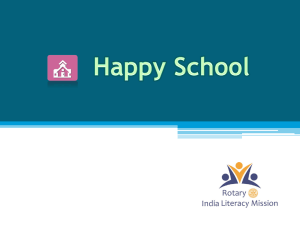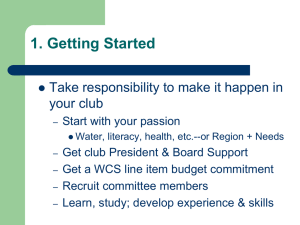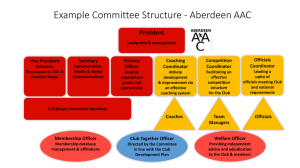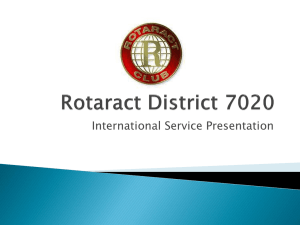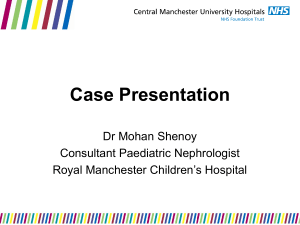FINAL Role of Volunteers in Happy Schools - Rotary T-E-A-C-H
advertisement
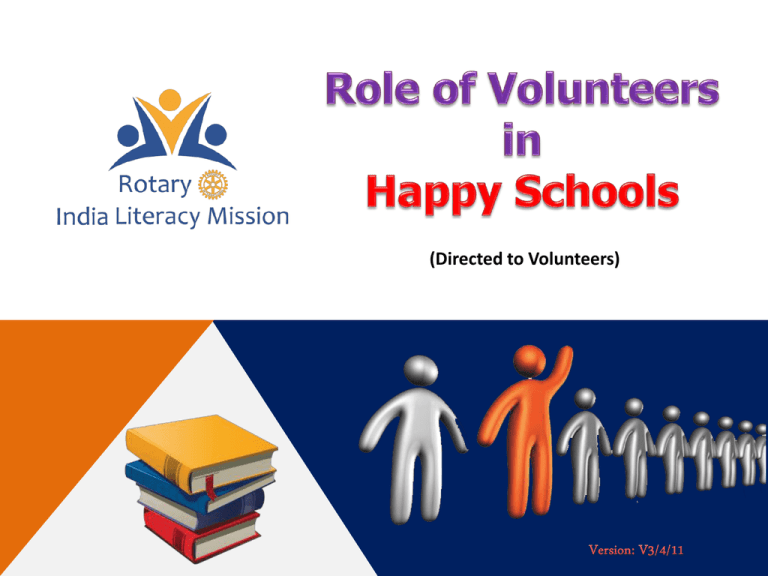
(Directed to Volunteers) To make “Happy Schools”, we need your help in: 1. Surveying Government/Government-aided/municipal/zilla parishad elementary (class I-VIII) or primary (I-V) schools 2. Setting up libraries in selected schools (including schools which may not be included in the Happy Schools Project (HSP)) 3. Cleaning and painting school buildings under HSP 4. Periodical monitoring of schools made “Happy” www.rotaryteach.org 1. Your Role in surveying prospective schools (Government/Government aided Municipal/ZP elementary schools for the HSP: Meet the Club President (CP)/Club Literacy Committee Chair (CLCC) of the Rotary club you have decided to work with and understand the selection criteria for the HSP As advised by the CP or CLCC, select 3 schools of any of the types mentioned above in the town or villages near the club Acquaint yourself with the School Information Form No. H1/3 available on the website at (http://www.rotaryteach.org/downloadFORMS/School_Information_Form.pdf) www.rotaryteach.org Get a letter of introduction from the CP/CLCC with request to the Head Teachers of the schools to allow you to do the survey. Speak to the concerned authorities (head teacher) and request permission to conduct the survey in the schools. Explain intent of the survey in simple, clear terms. It is advisable not to make commitment about the Happy Schools Project, since all schools surveyed might not be adopted under the Happy Schools Project www.rotaryteach.org Conduct the survey using this form, after speaking with the Head Teacher, some other Teachers and undertaking a physical inspection of the school Take pictures of the school and its facilities. This will help substantiate the survey information Submit the completed survey forms and pictures to the CP or CLCC www.rotaryteach.org An Introduction to Library Creation by RILM Libraries are the means for children to draw fun and excitement from education and learning. However, several Government / Government Aided Schools are not furnished with effective libraries. They may be in the Head Teacher’s room, thus discouraging children from uninhibited access, or the books may not be suitable/ engaging for the children. In the month of July, 17,76,357 story books/ encyclopedias and other books, for all classes, in vernacular languages which are not related to school syllabi, were collected by Rotary Clubs across India. www.rotaryteach.org RILM believes that children should have easy access to books and thus with help from the Akanksha Foundation the concept of classroom libraries in library jackets was adopted. The picture of the library jacket follows Thus, RILM will create classroom libraries in this way where possible, or traditional libraries in separate rooms, as decided by the Clubs in collaboration with school authorities. www.rotaryteach.org 2. Your Role in Setting up libraries in selected schools (including schools which may not have been selected for HSP): You will be invited to attend an orientation session to understand the GROW BY method of colour coding to segregate books in 6 categories, according to levels of difficulty in reading and comprehension. You are requested to understand the technique thoroughly and seek any clarifications required. You can tutor yourself in this method as well by looking at the presentation and video available at http://rotaryteach.org/library.shtml Start sorting the books by the GROW BY method. Try to sort 50 books in an hour! www.rotaryteach.org Start creating book sets once you finish sorting the books given to you. The table that follows will show what class-wise book sets should contain Class I II III IV V VI VII Class Strength* 40 25 30 20 30 40 25 Number of Books/Student 3 3 3 3 3 3 3 Number of Books 120 75 90 60 90 120 75 Type of Books/ Book Set G and R G,R, and O G,R, O and W G, R, O and W G,R,O,W and B G,R,O,W,B and Y G,R,O,W,B and Y *The class strengths are hypothetical. The book sets are to be created, assuming three books are needed per student. iv. Go ahead with installing the class-wise book sets in either library jackets or as traditional libraries in cupboards or book racks. www.rotaryteach.org 3. Your Role in Cleaning and Painting School Buildings: Go to the schools adopted to be turned into Happy Schools and encourage the children to come up with ideas and paint a wall or a section of a wall of the school building Check with the CP/CLCC if a group of volunteers can be formed to conduct a cleanliness drive in the schools. Set an example, encourage children and teachers to join in. If you are good at painting, it will be a good idea to paint some meaningful/fun pictures related to education and which would appeal to children, along with some interesting slogans, on the walls www.rotaryteach.org 4. Your Role in Periodic monitoring of schools made “Happy” : Obtain a list of the schools made “Happy” by the Rotary Club and select two schools, to undertake a post completion survey After 6 months of completion of a Happy School Project, as directed by a Club, conduct a physical inspection of the schools and talk to the students and teachers about the facilities and take photographs/take videos if permitted. www.rotaryteach.org Ask questions such to assess the condition of the new facilities installed in the schools. a. If you find the facilities are well-maintained and there is a sense of satisfaction among the users, you could ask for the reasons behind this. b. If you find that the facilities are not well maintained and there is dissatisfaction among users, ask for reasons for the same as well. All this information gathered has to be then handed over to the Club Presidents / Club Literacy Committee Chairs. www.rotaryteach.org
